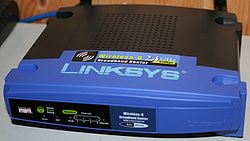| DD-WRT | |
|---|---|
 | |
 DD-WRT's Web interface | |
| Developer | Sebastian Gottschall / NewMedia-NET |
| Initial release | 22 January 2005 [1] |
| Stable release | v24 SP1 (Build 10020) [2] / 27 July 2008 |
| Preview release | 3.0 rolling beta [3] |
| Repository | |
| Type | Router operating system |
| License | Various proprietary and free software |
| Website | dd-wrt |

DD-WRT is Linux-based firmware for wireless routers and access points. Originally designed for the Linksys WRT54G series, it now runs on a wide variety of models. DD-WRT is one of a handful of third-party firmware projects designed to replace manufacturer's original firmware with custom firmware offering additional features or functionality.
Contents
Sebastian Gottschall, a.k.a. "BrainSlayer", is the founder and primary maintainer of the DD-WRT project. [4] The letters "DD" in the project name are the German license-plate letters for vehicles from Dresden, where the development team lived. [5] The remainder of the name was taken from the Linksys WRT54G model router, a home router popular in 2002–2004. WRT is assumed to be a reference to 'wireless router'.
Buffalo Technology and other companies have shipped routers with factory-installed, customized versions of DD-WRT. [6] [7] In January 2016, Linksys started to offer DD-WRT firmware for their routers. [8]